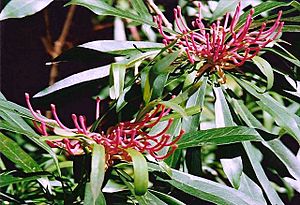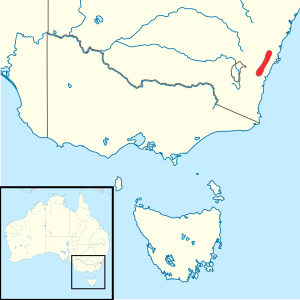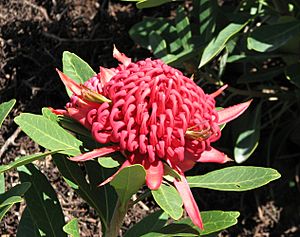Monga waratah facts for kids
Quick facts for kids Monga waratah |
|
|---|---|
 |
|
| Telopea mongaensis growing in Monga National Park | |
| Scientific classification | |
| Genus: |
Telopea
|
| Species: |
mongaensis
|
 |
|
| Where Telopea mongaensis grows | |
The Telopea mongaensis, also called the Monga waratah or Braidwood waratah, is a type of shrub or small tree. It belongs to the plant family Proteaceae. This plant only grows in Australia. You can find it in the high areas of southeastern New South Wales. It often grows in wet places, like the edge of rainforests or next to streams in eucalyptus forests.
The Monga waratah can grow up to 6 meters (about 20 feet) tall. It has thin green leaves that are 4 to 18 cm (1.5 to 7 inches) long and 0.5 to 2 cm (0.2 to 0.8 inches) wide. In spring, it produces many bright red flowerheads. Each flowerhead is made of 28 to 65 small flowers. In gardens, this plant likes soil that drains well and stays moist. It can grow in sunny or partly shaded spots. There are also special types of waratahs that are a mix of the Monga waratah and another waratah called Telopea speciosissima.
Contents
What it Looks Like
The Telopea mongaensis is a tall shrub that can reach up to 6 meters (about 20 feet) in height. Its leaves are thin and green. They measure between 4 and 18 cm (1.5–7 inches) long and 0.5 to 2 cm (0.2–0.8 inches) wide.
The plant's red flowers appear in spring. The flowerheads are not as big and showy as some other waratahs. But the plant produces many more of them. Each flowerhead is about 6 to 10 cm (2.4–3.9 inches) across. It contains 28 to 65 tiny individual flowers. Each small flower is covered by a part called a perianth. This part is a brighter red on the inside than on the outside. The flowers open from the center of the flowerhead outwards.
Green or pink leafy parts called bracts surround the flowerheads. These bracts are 1.2 to 4.5 cm (0.5–1.8 inches) long. They are not as noticeable as the bracts on the New South Wales Waratah. After flowering, woody seed pods grow. These pods are 4.5 to 7 cm (1.8–2.8 inches) long. When they are ready, the pods split open lengthwise. This releases the seeds.
You can tell the Monga waratah apart from a similar plant, Telopea oreades. The T. oreades usually has bigger leaves. It often grows more like a tree. Its leaves also have fewer visible veins. If they grow in the same area, Telopea oreades flowers about a month earlier than T. mongaensis.
How it Got its Name
The Telopea mongaensis was first described by an Australian botanist named Edwin Cheel. This happened in 1947. Its scientific name, mongaensis, comes from the Monga National Park area where it grows. The first plant specimen used to describe the species was found on Sugarloaf Mountain near Braidwood.
People often call it the Monga waratah or Braidwood waratah. For a while, some thought it was just a different type of Telopea oreades. But later, scientists looked closely under a microscope. They found that T. oreades had special features called sclereids, which T. mongaensis did not have. This helped show they were different species.
Sometimes, the Telopea oreades and T. mongaensis grow near each other. They can even create hybrid plants, which are a mix of both. Scientists believe that waratah populations grew and shrank during the ice ages. This led to some T. oreades plants being left alongside T. mongaensis as the climate changed. The Monga waratah has also mixed with T. speciosissima where their growing areas overlap.
The Telopea mongaensis is one of five species in the Telopea group found in southeastern Australia. It is most closely related to T. oreades. The next closest relative is the Tasmanian waratah (T. truncata). All these waratah plants are part of a larger group called Embothriinae. This group also includes tree waratahs from eastern Australia and New Caledonia, and plants from South America. Most of these plants have red flowers at the end of their branches. This suggests that their common ancestor lived over 60 million years ago. This was before the supercontinent Gondwana split into Australia, Antarctica, and South America.
Where it Grows and Lives
You can find the Monga waratah between Fitzroy Falls in the north and Monga National Park to the south. It likes to live on the edges of cool rainforests or in wet eucalyptus forests. You might see it along creeks or on mountain slopes. It grows at heights between 540 and 760 meters (1,770–2,500 feet) above sea level.
It prefers sandy soils that have been carried by water. It often grows near trees like brown barrel (Eucalyptus fastigata), silvertop ash (E. sieberi), and Sydney peppermint (E. piperita). Other plants that grow with it include pinkwood (Eucryphia moorei), soft tree fern (Dicksonia antarctica), and hairpin banksia (Banksia spinulosa). The areas where it grows usually get 1000 to 1100 mm (39–43 inches) of rain each year.
Ecology and Life Cycle
The bright red flowers and their position on the Telopea mongaensis suggest that birds help pollinate it. This has likely been happening for over 60 million years.
The Monga waratah has a special woody base called a lignotuber. This part is mostly underground. It stores energy and nutrients. This helps the plant grow back quickly after a bushfire. New shoots can grow from the lignotuber even if the rest of the plant above ground burns. The seeds also grow well in soil after a bushfire. This soil has more nutrients and fewer other plants competing for space. Animals often eat waratah seeds, which destroys them. The seeds usually do not travel far from the parent plants.
Growing Waratahs in Gardens
Early attempts to grow the Monga waratah in Sydney were not successful. However, Telopea mongaensis is actually quite tough. It can handle more shade, heavier soils, and cooler weather than some of its flashier relatives. If grown in full sun, it stays smaller, around 2 meters (6.6 feet) tall. It can also survive frost. It has even been grown in southern England. In 1980, it received an Award of Merit from the Royal Horticultural Society. This plant is great for attracting birds to your garden.
Telopea 'Braidwood Brilliant' is a special hybrid plant. It is a mix between the Monga waratah and the showy Telopea speciosissima. This hybrid was first grown in 1962 and officially registered in 1974. It was created by Reverend Colin Burgess. He chose parent plants from cold areas to make a very strong plant. Pollen from T. speciosissima plants was used on T. mongaensis plants from Braidwood. This hybrid plant grows to about 4 meters (13 feet) tall. Its flower heads are 6 to 8 cm (2.4–3.1 inches) across. They can handle frosts as cold as -6°C (21°F). However, they might not do well in very hot climates.
See also
 In Spanish: Telopea mongaensis para niños
In Spanish: Telopea mongaensis para niños


